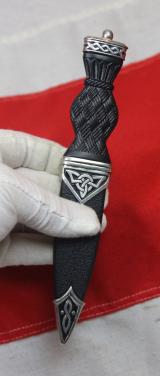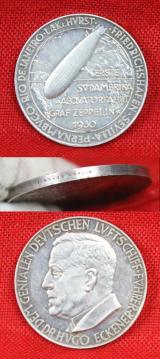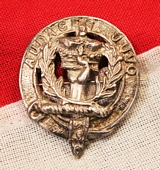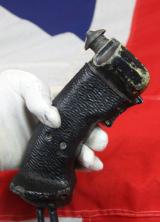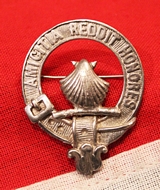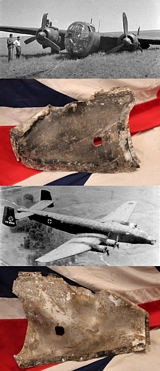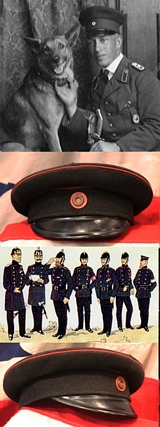WW1 / WW2 / 20th Century
Celtic Sgian Dubh with Polished Pewter Celtic Knotwork Patterned Mounts. For Wear In Full Highland Dress,
Ball knop top. A bright polished steel blade in a Sgian Dubh presentation box.
The sgian-dubh is a small, single-edged knife worn as part of traditional Scottish Highland dress along with the kilt. Originally used for eating and preparing fruit, meat, and cutting bread and cheese, as well as serving for other more general day-to-day uses such as cutting material and protection, it is now worn as part of traditional Scottish dress tucked into the top of the kilt hose with only the upper portion of the hilt visible. The sgian-dubh is normally worn on the same side as the dominant hand.
The sgian-dubh may have evolved from the sgian-achlais, a dagger that could be concealed under the armpit. Used by the Scots of the 17th and 18th centuries, this knife was slightly larger than the average modern sgian-dubh and was carried in the upper sleeve or lining of the body of the jacket.
Courtesy and etiquette would demand that when entering the home of a friend, any concealed weapons would be revealed. It follows that the sgian-achlais would be removed from its hiding place and displayed in the stocking top held securely by the garters
Vintage, around 10 years old read more
45.00 GBP
A Very Fine 1920's to 30's Silver Gilt & Enamel Graf von Zeppelin Demi-Tasse Cabinet Spoon, With Enamel Portrait of Zeppelin & a Zeppelin Airship in the Spoon Bowl
Superb condition and a most charming and collectable object d'art. Ferdinand von Zeppelin served as an official observer with the Union Army during the American Civil War. During the Peninsular Campaign, he visited the balloon camp of Thaddeus S. C. Lowe. Lowe sent the curious von Zeppelin to another balloon camp where the German-born aeronaut John Steiner could be of more help to the young man. His first ascent in a balloon, made at Saint Paul, Minnesota during this visit, is said to have been the inspiration of his later interest in aeronautics.
Zeppelin's ideas for large dirigibles was first expressed in a diary entry dated 25 March 1874. Inspired by a recent lecture given by Heinrich von Stephan on the subject of "World Postal Services and Air Travel", he outlined the basic principle of his later craft: a large rigidly-framed outer envelope continuing a number of separate gasbags. In 1887 the success of Charles Renard and Arthur Krebs' airship La France prompted him to send a letter to the King of Württemberg about the military necessity for dirigibles and the lack of German development in this field. He went on to start the Zeppelin Airship Co. and his name lived on in German legend as the great airship pioneer of international travel and airship warfare. read more
235.00 GBP
A Rare German Aerospace Zeppelin First Flight To South America, .835 Silver Medal, 1930 Made In Berlin
Silver medal 1930 (O. Glöckler) The "LZ 127" made its first trip to South America. bust of dr. H. Eckener to the left / Airship over the Atlantic between Europe and South America. Edge punch: (half moon) 835 PR. BERLIN COIN. 36 mm, 24.59 Min. Scratches. excellent ++ condition
LZ 127 Graf Zeppelin (Deutsches Luftschiff Zeppelin 127) was a German passenger-carrying, hydrogen-filled rigid airship that flew from 1928 to 1937. It offered the first commercial transatlantic passenger flight service. Named after the German airship pioneer Ferdinand von Zeppelin, a count (Graf) in the German nobility, it was conceived and operated by Dr. Hugo Eckener, the chairman of Luftschiffbau Zeppelin.
Graf Zeppelin made 590 flights totalling almost 1.7 million kilometres (over 1 million miles). It was operated by a crew of 36, and could carry 24 passengers. It was the longest and largest airship in the world when it was built. It made the first circumnavigation of the world by airship, and the first nonstop crossing of the Pacific Ocean by air; its range was enhanced by its use of Blau gas as a fuel. It was built using funds raised by public subscription and from the German government, and its operating costs were offset by the sale of special postage stamps to collectors, the support of the newspaper magnate William Randolph Hearst, and cargo and passenger receipts.
After several long flights between 1928 and 1932, including one to the Arctic, Graf Zeppelin provided a commercial passenger and mail service between Germany and Brazil for five years. When the Nazi Party came to power, they used it as a propaganda tool. It was withdrawn from service after the Hindenburg disaster in 1937, and scrapped for military aircraft production in 1940.
A most scarce piece, but remarkably we acquired this fine example thanks to another example that we have. That past medal was spotted by this rare medal's owner on our website, and they offered it to us. It is only the second of its type of this rare medal we have had in over 10 years. read more
260.00 GBP
1924 Graf Zeppellin Z.R. III, The USS Los Angeles, Airship Medal, For The Flight of The Zeppelin, Previously Known As The LZ126, To America. A Most Rare Example
1000 Hallmarked Silver Coin Medal
GERMANY, Weimarer Republik. 1918-1933. AR Medal (40mm, 25.68 g, 12h). The Flight of Zeppelin LZ126 to America. By A. Holl. Dated 1924. FERDINAND GRAF VON ZEPPELIN, uniformed bust of Ferdinand von Zeppelin right / LZ126 in flight left over Manhattan; Z.R.III above, 1924 below. Kaiser 459. EF, toned.
As part of their reparations payments for the First World War, Germany was required to give its remaining military zeppelins to the victorious Allied powers. This did not sit well with the crews of the ships who, only a week before the Treaty of Versailles was signed, destroyed many of the airships, following the example of their brothers-in-arms at Scapa Flow, who scuttled the German navy earlier that year. Germany was thus required to construct new zeppelins to replace those lost.
Among these was LZ126, destined for service in the United States Navy. The zeppelin was delivered to the US Naval Air Station in Lakehurst, New Jersey on 12 October 1924, and was commissioned into the US Navy as ZR-3, the USS Los Angeles on 25 November. She would be the first of the Navy's brief foray into light-than-air vessels, to be followed by the Shenandoah, Macon, and Akron, and was the only vessel of her class to not succumb to disaster. Zeppelins, always particularly susceptible to the vagaries of winds and weather, were soon overshadowed by the development of vastly more reliable airplanes of the 1930s. The USS Los Angeles was decommissioned in 1932 and was dismantled in 1939. read more
220.00 GBP
Scottish Silver Buchanen 'Audaces Juvo' Clan Glengarry Badge 1930's
Not hallmarked silver. Clan Buchanan Audaces Juvo I Help the Brave. Is an armigerous Scottish clan whose origins are said to lie in the 1225 grant of lands on the eastern shore of Loch Lomond to clergyman Sir Absalon of Buchanan by the Earl of Lennox. A Dexter Hand Holding Up A Ducal Cap Proper., Tufted On The Top With A Rose Gu., All Within Two Laurel-Branches In Orle Vert. Traditionally, the Glengarry bonnet is said to have first appeared as the head dress of the Glengarry Fencibles when they were formed in 1794 by Alexander Ranaldson MacDonell of Glengarry, of Clan MacDonell of Glengarry. MacDonell, therefore, is sometimes said to have invented the glengarry - but it is not clear whether early pictures of civilians or fencible infantry show a true glengarry, capable of being folded flat, or the standard military bonnet of the period merely 'cocked' into a more 'fore-and-aft' shape. The first use of the classic, military glengarry may not have been until 1841, when it is said to have been introduced for the pipers of the 79th Foot by the commanding officer, Lieutenant Colonel Lauderdale Maule.
It was only in the 1850s that the glengarry became characteristic undress headgear of the Scottish regiments of the British Army. By 1860, the glengarry without a diced border and usually with a feather had been adopted by pipers in all regiments except the 42nd (Black Watch), whose pipers wore the full dress feather bonnet. In 1914, all Scottish infantry regiments were wearing dark blue glengarries in non-ceremonial orders of dress, except for the Cameronians (Scottish Rifles) who wore them in rifle green, and the Scots Guards, who wore peaked forage caps or khaki service dress caps. read more
65.00 GBP
A Fabulous Piece of British Armed Forces Helicopter Aeronautica. A Souvenir of the Falklands War, A Westland Wessex Helicopter Cyclic Control Grip With Wiring
We acquired this from a former SF Falklands War veteran, who brought it back from the South Atlantic. It came from a Westland Wessex helicopter that had, apparently, somewhat, come a cropper. Of course we have no idea which chopper this control grip came from, and it certainly couldn't likely have come from a maritime loss, but none the less it is a great original part of the Westland Wessex, in pretty good condition, considering its circumstances of acquisition. It bears a serial number and its wiring portion.
Around 55 Westland Wessex HU.5s participated in the Falklands War, fighting in the South Atlantic in 1982. On 21 May 1982, 845 Squadron's Wessex HU.5s supported British landings on East Falkland. The type was heavily used throughout the conflict for the transportation and insertion of British special forces, including members of the Special Air Service (SAS) and the Special Boat Service (SBS). A total of nine Wessex (eight HU.5s and one HAS.3) were lost during the Falklands campaign. Two HU.5s of 845 Squadron crashed on the Fortuna Glacier in South Georgia during an attempt to extract members of the SAS during a snow storm, six of 848 Squadron's Wessex HU.5s were lost when the container ship Atlantic Conveyor was sunk and the HAS.3 aboard HMS Glamorgan was destroyed when the ship was struck by an Exocet missile.
The Falklands War was a ten-week undeclared war between Argentina and the United Kingdom in 1982 over two British dependent territories in the South Atlantic: the Falkland Islands and its territorial dependency, South Georgia and the South Sandwich Islands.
The conflict began on 2 April, when Argentina invaded and occupied the Falkland Islands, followed by the invasion of South Georgia the next day. On 5 April, the British government dispatched a naval task force to engage the Argentine Navy and Air Force before making an amphibious assault on the islands. The conflict lasted 74 days and ended with an Argentine surrender on 14 June, returning the islands to British control. In total, 649 Argentine military personnel, 255 British military personnel, and three Falkland Islanders were killed during the hostilities.
The conflict was a major episode in the protracted dispute over the territories' sovereignty. Argentina asserted (and maintains) that the islands are Argentine territory, and the Argentine government thus characterised its military action as the reclamation of its own territory. The British government regarded the action as an invasion of a territory that had been a Crown colony since 1841. Falkland Islanders, who have inhabited the islands since the early 19th century, are predominantly descendants of British settlers, and strongly favour British sovereignty. Neither state officially declared war, although both governments declared the islands a war zone.
The conflict has had a strong effect in both countries and has been the subject of various books, articles, films, and songs. Patriotic sentiment ran high in Argentina, but the unfavourable outcome prompted large protests against the ruling military government, hastening its downfall and the democratisation of the country. In the United Kingdom, the Conservative government, bolstered by the successful outcome, was re-elected with an increased majority the following year. The cultural and political effect of the conflict has been less in the UK than in Argentina, where it has remained a common topic for discussion.
Diplomatic relations between the United Kingdom and Argentina were restored in 1989 following a meeting in Madrid, at which the two governments issued a joint statement. No change in either country's position regarding the sovereignty of the Falkland Islands was made explicit. In 1994, Argentina adopted a new constitution, which declared the Falkland Islands as part of one of its provinces by law. However, the islands continue to operate as a self-governing British Overseas Territory read more
325.00 GBP
Original Vintage Scottish Pringle Clan Bonnet Badge, with Latin Clan Motto 'Amicitia Reddit Honores' With Clam Shell Crest Hallmarked Edinburgh Silver
The motto reads 'Friendship Gives Honour'. In the 14th century the family were close allies of the Earls of Douglas, to whom they were squires, and about the end of that era they are first defined as Hoppringle of that Ilk, holding the lands of Earlside in Lauderdale. Descendants were much in evidence at the Courts of James IV and V, at least two being trumpeters in the tail of James IV and one falling at his side at Flodden in 1513. For 100 years, from about 1489, a succession of Pringle ladies, usually younger daughters, were Prioresses of the Convent at Coldstream. The association of Pringles with the woollen industry may be traced to 1540 when one of their name held the responsibility for overseeing the shearing, storage and transportation of the wool from the King's sheep. In 1592 various Pringles appeared before the King, with other Border lairds, giving an oath to faithfully serve the Wardens of the East and Middle Marches, and evidence of their extended land-holdings is shown by no less than six cadet families standing surety, one for the other, in keeping the peace. Five years later, Pringle of that Ilk and Pringle of Smailholm subscribed to a Bond of Manrent, taking it upon themselves the burden of ensuring the good behaviour of Pringles in general. The last Pringle of that Ilk died in 1737, after which the principal family became the Pringles of Stitchill, the lands of which were acquired c.1630. Of this latter house, Sir Robert was created a Baronet of Nova Scotia in 1683 and, although the lands have now been sold, the Baronetcy has survived into the 21st century, the current baronet title being.
Sir Norman Murray Archibald MacGregor Pringle of that Ilk and Stichill, 10th Baronet
Several Pringles have become Senators of the College of Justice in Scotland, which comes with the title and rank of Lord of Session.
On 6 June 1718 Sir Walter Pringle became Lord Newhall.
On 1 July 1729 John Pringle of The Haining became Lord Haining.
On 20 November 1754 Robert Pringle became Lord Edgefield.
On 14 June 1757 Andrew Pringle became Lord Alemore. read more
165.00 GBP
A Large Original Recovered Piece of a WW2 German Crashed Bomber's Alloy Wing Top Panel
Taken from a crashed German bomber, with original wing-top paint. Numerous rivet holes and rivet heads present. Typical german wing-top paint for a bomber aircraft. There is a partial printed word on the underside and with dilligent research it should be traceable to a specific bomber type.
Over the years we have had some amazing aeronautical archeological finds, and most have been identified by their approved, and gov. registered recoverers, yet this fine piece was placed in storage, and it’s plane I’d was mislaid, so the research for it has to start again if it is needed, but the price reflects that, and it may well reveal wonderful results.
14.75 inches x 22.0 inches. Just over 3.5 pounds weight. read more
395.00 GBP
Imperial German Peaked Cap for Fire Protection Officer of Lubeck
Blue wool cloth with two red piping borders and single red and brass disc roundel. In super condition, worn areas to the lining and sweatband, as to be expected, but the peak and dark blue cloth are superb. Made in WW1 Imperial period, worn right through the later Weimar period and into the early Third Reich era. When used in the Third Reich era, by the Fire Protection Police, it was an organization that was an auxiliary to the Ordnungspolizei, and during the war was absorbed into the SS. Feuerschutzpolizei. By 1938, all of Germany's local fire brigades were part of the ORPO. Orpo Hauptamt had control of all civilian fire brigades. ORPO's chief was SS-Oberstgruppenf?hrer Kurt Daluege who was responsible to Himmler alone until 1943 when Daluege had a massive heart attack. From 1943, Daluege was replaced by Obergruppenf?hrer Alfred W?nnenberg until May 1945.
ORPO was structurally reorganised by 1941. It had been divided into the numerous offices covering every aspect of German law enforcement in accordance with Himmler's desire for public control of all things.
A very attractive and interesting piece in super order and totally complete. read more
285.00 GBP
A Very Fine Pair of Cased WW1 Great War Imperial German Epaulettes
For the Imperial German 40th Infantry officer. Used by the German regimental officers that fought in the trenches with Adolf Hitler's infantry, and apparently the 40th relieved Hitler's company within the List Regiment, the Bavarian Reserve Infantry Regiment 16 (1st Company of the List Regiment). In their original storage case in mint condition overall. Mid blue cloth background with gilt crescent and Infantry number 40. Red back cloth. During the war, Hitler served in France and Belgium in the Bavarian Reserve Infantry Regiment 16 (1st Company of the List Regiment). He was an infantryman in the 1st Company during the First Battle of Ypres (October 1914), which Germans remember as the Kindermord bei Ypern (Ypres Massacre of the Innocents) because approximately 40,000 men (between a third and a half) of nine newly-enlisted infantry divisions became casualties in 20 days. Hitler's regiment entered the battle with 3,600 men and at its end mustered 611. By December Hitler's own company of 250 was reduced to 42. Biographer John Keegan claims that this experience drove Hitler to become aloof and withdrawn for the remaining years of war. After the battle, Hitler was promoted from Sch?tze (Private) to Gefreiter (Lance Corporal). He was assigned to be a regimental message-runner The List Regiment fought in many battles, including the First Battle of Ypres (1914), the Battle of the Somme (1916), the Battle of Arras (1917), and the Battle of Passchendaele (1917). During the Battle of Fromelles on 19?20 July 1916 the Australians, mounting their first attack in France, assaulted the Bavarian positions. The Bavarians repulsed the attackers, suffering the second-highest losses they had on any day on the Western Front, about 7,000 men read more
295.00 GBP


